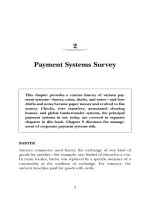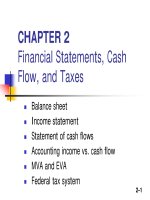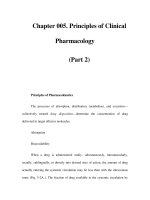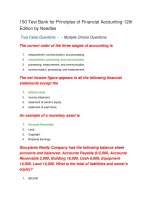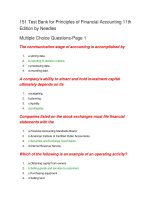Lecture Principles of financial accouting - Chapter 2: Analyzing and recording transactions
Bạn đang xem bản rút gọn của tài liệu. Xem và tải ngay bản đầy đủ của tài liệu tại đây (1.71 MB, 38 trang )
Chapter 2
Analyzing and Recording
Transactions
PowerPoint Authors:
Susan Coomer Galbreath, Ph.D., CPA
Charles W. Caldwell, D.B.A., CMA
Jon A. Booker, Ph.D., CPA, CIA
Cynthia J. Rooney, Ph.D., CPA
Winston Kwok, Ph.D., CPA
McGrawHill/Irwin
Copyright © 2011 by The McGrawHill Companies, Inc. All rights reserved.
2 2
C 1
Analyzing and Recording Process
Analyze each transaction and
event from source documents
Prepare and analyze
the trial balance
Record relevant transactions
and events in a journal
Post journal information
to ledger accounts
2 3
C 1
Source Documents
Checks
Employee
Earnings
Records
Bills from
Suppliers
Purchase
Orders
Bank
Statements
Sales
Tickets
2 4
C 2
The Account and its Analysis
An
An account
account is
is aa
record
record of
of
increases
increases and
and
decreases
decreases in
in aa
specific
specific asset,
asset,
liability,
liability, equity,
equity,
revenue,
revenue, or
or
expense
expense item.
item.
The
The general
general
ledger
ledger is
is aa record
record
containing
containing all
all
accounts
accounts used
used by
by
the
the company.
company.
2 5
C 2
The Account and its Analysis
Owner,
Owner, Capital
Capital
Owner,
Owner, Withdrawals
Withdrawals
2 6
C 2
Asset Accounts
Cash
Cash
Land
Land
Buildings
Buildings
Asset
Asset
Accounts
Accounts
Equipment
Equipment
Supplies
Supplies
Accounts
Accounts
Receivable
Receivable
Notes
Notes
Receivable
Receivable
Prepaid
Prepaid
Accounts
Accounts
2 7
C 2
Liability Accounts
Accounts
Accounts
Payable
Payable
Notes
Notes
Payable
Payable
Liability
Liability
Accounts
Accounts
Accrued
Accrued
Liabilities
Liabilities
Unearned
Unearned
Revenue
Revenue
2 8
C 2
Equity Accounts
Owner’s
Owner’s
Capital
Capital
Owner’s
Owner’s
Withdrawals
Withdrawals
Equity
Accounts
Revenues
Revenues
Expenses
Expenses
2 9
C 2
The Account and its Analysis
Assets
=
Liabilities
+
Equity
2 10
C 3
Ledger and Chart of Accounts
The
The ledger
ledger is
is aa collection
collection of
of all
all accounts
accounts for
for an
an
information
information system.
system. A
A company
company’s
’s size
size and
and diversity
diversity
of
of operations
operations affect
affect the
the number
number of
of accounts
accounts needed.
needed.
The chart of accounts is a list of all accounts and includes an
identifying number for each account.
Account Number
101
106
126
128
167
201
236
301
Account Name
Cash
Accounts receivable
Supplies
Prepaid insurance
Equipment
Accounts payable
Unearned revenue
C. Taylor, Capital
Account Number
302
403
406
622
637
640
652
690
Account Name
C. Taylor, Withdrawals
Revenues
Rental revenue
Salaries expense
Insurance expense
Rent expense
Supplies expense
Utilities expense
2 11
C 4
Debits and Credits
A T-account represents a ledger account and
is a tool used to understand the effects of
one or more transactions.
Account Title
(Left side)
(Right side)
Debit
Credit
2 12
C 4
Double-Entry Accounting
Assets
ASSETS
Debit Credit
+
Normal
Normal
=
Liabilities
LIABILITIES
Debit Credit
+
Normal
Normal
+
Equity
EQUITIES
Debit Credit
+
Normal
Normal
2 13
C 4
Double-Entry Accounting
Equity
Owner’s
’s
Owner
Capital
Capital
_
Owner's
Owner's
Withdrawals
Withdrawals
+
Revenues
Revenues
Owner’s
Capital
Owner's
Withdrawals
Revenues
Debit Credit
Debit Credit
Debit Credit
+
+
+
_ Expenses
Expenses
Expenses
Debit Credit
+
2 14
C 4
Double-Entry Accounting
An account balance is the difference between the increases
and decreases in an account. Notice the T-Account.
2 15
P 1
JOURNALIZING &
POSTING TRANSACTIONS
Assets
Assets
=
Liabilities
Liabilities
+
Equity
Equity
T- Account
(Left side)
(Right side)
Debit
Credit
Step 1: Analyze
transactions and source
documents.
ACCOUNT NAME:
Date
Step 2: Apply double
entry accounting
ACCOUNT No.
Description
PR
Debit
Credit
Balance
Step 4: Post entry to ledger
Step 3: Record journal entry
2 16
P 1
Journalizing Transactions
Transaction
Transaction
Date
Date
Date
2011
Dec. 1 Cash
Titles
Titles of
of Affected
Affected
Accounts
Accounts
Description
Debit
Credit
30,000
C. Taylor, Capital
Investment by owner
Dec. 2 Supplies
Cash
Purchased supplies for cash
Transaction
Transaction
explanation
explanation
30,000
2,500
2,500
Dollar
Dollar amount
amount of
of debits
debits
and
and credits
credits
2 17
P 1
Balance Column Account
T-accounts are useful illustrations, but balance
column ledger accounts are used in practice.
2 18
P 1
Posting Journal Entries
2011
Dec. 1 Cash
30,000
C. Taylor, Capital
Investment by owner
11
Identify the debit account in ledger.
30,000
2 19
P 1
Posting Journal Entries
2011
Dec. 1 Cash
30,000
C. Taylor, Capital
Investment by owner
22
Enter the date.
30,000
2 20
P 1
Posting Journal Entries
2011
Dec. 1 Cash
30,000
C. Taylor, Capital
Investment by owner
33
Enter the amount and description.
30,000
2 21
P 1
Posting Journal Entries
2011
Dec. 1 Cash
30,000
C. Taylor, Capital
Investment by owner
44
Enter the journal reference.
30,000
2 22
P 1
Posting Journal Entries
2011
Dec. 1 Cash
30,000
C. Taylor, Capital
Investment by owner
55
Compute the balance.
30,000
2 23
P 1
Posting Journal Entries
2011
Dec. 1 Cash
101
C. Taylor, Capital
Investment by owner
66
Enter the ledger reference.
30,000
30,000
2 24
A 1
Analyzing Transactions
Analysis:
Posting:
(1)
Cash
30,000
101
C. Taylor, Capital
(1)
301 301
30,000
2 25
A 1
Analyzing Transactions
Analysis:
Double entry:
(2)
Supplies
Cash
126
101
2,500
2,500
Posting:
(2)
Supplies
2,500
126
(1)
Cash
30,000
101
(2)
2,500
